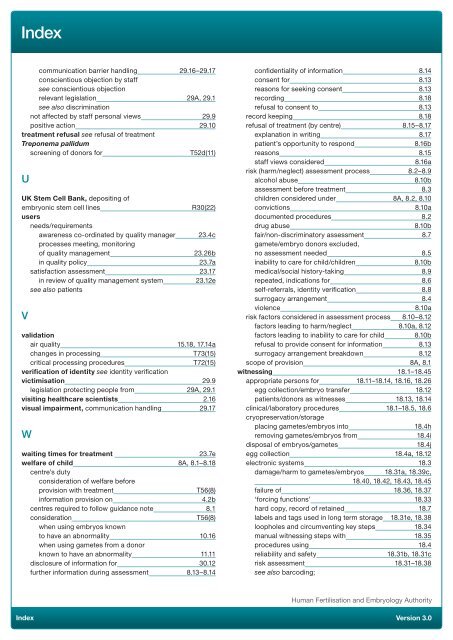Eighth Edition - R.3 - Human Fertilisation & Embryology Authority
Eighth Edition - R.3 - Human Fertilisation & Embryology Authority
Eighth Edition - R.3 - Human Fertilisation & Embryology Authority
Create successful ePaper yourself
Turn your PDF publications into a flip-book with our unique Google optimized e-Paper software.
Index<br />
communication barrier handling 29.16–29.17<br />
conscientious objection by staff<br />
see conscientious objection<br />
relevant legislation 29A, 29.1<br />
see also discrimination<br />
not affected by staff personal views 29.9<br />
positive action 29.10<br />
treatment refusal see refusal of treatment<br />
Treponema pallidum<br />
screening of donors for<br />
T52d(11)<br />
U<br />
UK Stem Cell Bank, depositing of<br />
embryonic stem cell lines<br />
R30(22)<br />
users<br />
needs/requirements<br />
awareness co-ordinated by quality manager 23.4c<br />
processes meeting, monitoring<br />
of quality management 23.26b<br />
in quality policy 23.7a<br />
satisfaction assessment 23.17<br />
in review of quality management system 23.12e<br />
see also patients<br />
V<br />
validation<br />
air quality 15.18, 17.14a<br />
changes in processing<br />
T73(15)<br />
critical processing procedures<br />
T72(15)<br />
verification of identity see identity verification<br />
victimisation 29.9<br />
legislation protecting people from 29A, 29.1<br />
visiting healthcare scientists 2.16<br />
visual impairment, communication handling 29.17<br />
W<br />
waiting times for treatment 23.7e<br />
welfare of child 8A, 8.1–8.18<br />
centre’s duty<br />
consideration of welfare before<br />
provision with treatment<br />
T56(8)<br />
information provision on 4.2b<br />
centres required to follow guidance note 8.1<br />
consideration<br />
T56(8)<br />
when using embryos known<br />
to have an abnormality 10.16<br />
when using gametes from a donor<br />
known to have an abnormality 11.11<br />
disclosure of information for 30.12<br />
further information during assessment 8.13–8.14<br />
confidentiality of information 8.14<br />
consent for 8.13<br />
reasons for seeking consent 8.13<br />
recording 8.18<br />
refusal to consent to 8.13<br />
record keeping 8.18<br />
refusal of treatment (by centre) 8.15–8.17<br />
explanation in writing 8.17<br />
patient’s opportunity to respond 8.16b<br />
reasons 8.15<br />
staff views considered 8.16a<br />
risk (harm/neglect) assessment process 8.2–8.9<br />
alcohol abuse 8.10b<br />
assessment before treatment 8.3<br />
children considered under 8A, 8.2, 8.10<br />
convictions 8.10a<br />
documented procedures 8.2<br />
drug abuse 8.10b<br />
fair/non-discriminatory assessment 8.7<br />
gamete/embryo donors excluded,<br />
no assessment needed 8.5<br />
inability to care for child/children 8.10b<br />
medical/social history-taking 8.9<br />
repeated, indications for 8.6<br />
self-referrals, identity verification 8.8<br />
surrogacy arrangement 8.4<br />
violence 8.10a<br />
risk factors considered in assessment process 8.10–8.12<br />
factors leading to harm/neglect 8.10a, 8.12<br />
factors leading to inability to care for child 8.10b<br />
refusal to provide consent for information 8.13<br />
surrogacy arrangement breakdown 8.12<br />
scope of provision 8A, 8.1<br />
witnessing 18.1–18.45<br />
appropriate persons for 18.11–18.14, 18.16, 18.26<br />
egg collection/embryo transfer 18.12<br />
patients/donors as witnesses 18.13, 18.14<br />
clinical/laboratory procedures 18.1–18.5, 18.6<br />
cryopreservation/storage<br />
placing gametes/embryos into 18.4h<br />
removing gametes/embryos from 18.4i<br />
disposal of embryos/gametes 18.4j<br />
egg collection 18.4a, 18.12<br />
electronic systems 18.3<br />
damage/harm to gametes/embryos 18.31a, 18.39c,<br />
18.40, 18.42, 18.43, 18.45<br />
failure of 18.36, 18.37<br />
‘forcing functions’ 18.33<br />
hard copy, record of retained 18.7<br />
labels and tags used in long term storage 18.31e, 18.38<br />
loopholes and circumventing key steps 18.34<br />
manual witnessing steps with 18.35<br />
procedures using 18.4<br />
reliability and safety 18.31b, 18.31c<br />
risk assessment 18.31–18.38<br />
see also barcoding;<br />
<strong>Human</strong> <strong>Fertilisation</strong> and <strong>Embryology</strong> <strong>Authority</strong><br />
Index<br />
Version 3.0

















